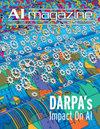Improving Alzheimer’s Disease and Brain Tumor Detection Using Deep Learning with Particle Swarm Optimization
IF 2.5
4区 计算机科学
Q3 COMPUTER SCIENCE, ARTIFICIAL INTELLIGENCE
引用次数: 1
Abstract
Convolutional Neural Networks (CNNs) have exhibited remarkable potential in effectively tackling the intricate task of classifying MRI images, specifically in Alzheimer’s disease detection and brain tumor identification. While CNNs optimize their parameters automatically through training processes, finding the optimal values for these parameters can still be a challenging task due to the complexity of the search space and the potential for suboptimal results. Consequently, researchers often encounter difficulties determining the ideal parameter settings for CNNs. This challenge necessitates using trial-and-error methods or expert judgment, as the search for the best combination of parameters involves exploring a vast space of possibilities. Despite the automatic optimization during training, the process does not guarantee finding the globally-optimal parameter values. Hence, researchers often rely on iterative experimentation and expert knowledge to fine-tune these parameters and maximize CNN performance. This poses a significant obstacle in developing real-world applications that leverage CNNs for MRI image analysis. This paper presents a new hybrid model that combines the Particle Swarm Optimization (PSO) algorithm with CNNs to enhance detection and classification capabilities. Our method utilizes the PSO algorithm to determine the optimal configuration of CNN hyper-parameters. Subsequently, these optimized parameters are applied to the CNN architectures for classification. As a result, our hybrid model exhibits improved prediction accuracy for brain diseases while reducing the loss of function value. To evaluate the performance of our proposed model, we conducted experiments using three benchmark datasets. Two datasets were utilized for Alzheimer’s disease: the Alzheimer’s Disease Neuroimaging Initiative (ADNI) and an international dataset from Kaggle. The third dataset focused on brain tumors. The experimental assessment demonstrated the superiority of our proposed model, achieving unprecedented accuracy rates of 98.50%, 98.83%, and 97.12% for the datasets mentioned earlier, respectively.基于粒子群优化的深度学习改进阿尔茨海默病和脑肿瘤检测
卷积神经网络(cnn)在有效处理复杂的MRI图像分类任务方面表现出了显著的潜力,特别是在阿尔茨海默病检测和脑肿瘤识别方面。虽然cnn通过训练过程自动优化参数,但由于搜索空间的复杂性和潜在的次优结果,找到这些参数的最优值仍然是一项具有挑战性的任务。因此,研究人员经常在确定cnn的理想参数设置时遇到困难。这一挑战需要使用试错法或专家判断,因为寻找参数的最佳组合涉及探索广阔的可能性空间。尽管在训练过程中进行了自动优化,但该过程不能保证找到全局最优的参数值。因此,研究人员经常依靠迭代实验和专家知识来微调这些参数并最大化CNN的性能。这对开发利用cnn进行MRI图像分析的实际应用构成了重大障碍。本文提出了一种新的混合模型,将粒子群优化算法(PSO)与cnn相结合,以提高检测和分类能力。我们的方法利用粒子群算法来确定CNN超参数的最优配置。随后,将这些优化后的参数应用到CNN架构中进行分类。因此,我们的混合模型在减少功能价值损失的同时,对脑部疾病的预测精度有所提高。为了评估我们提出的模型的性能,我们使用三个基准数据集进行了实验。两个数据集用于阿尔茨海默病:阿尔茨海默病神经影像学倡议(ADNI)和来自Kaggle的国际数据集。第三个数据集中于脑肿瘤。实验评估证明了我们提出的模型的优越性,在前面提到的数据集上分别达到了前所未有的98.50%、98.83%和97.12%的准确率。
本文章由计算机程序翻译,如有差异,请以英文原文为准。
求助全文
约1分钟内获得全文
求助全文
来源期刊

Ai Magazine
工程技术-计算机:人工智能
CiteScore
3.90
自引率
11.10%
发文量
61
审稿时长
>12 weeks
期刊介绍:
AI Magazine publishes original articles that are reasonably self-contained and aimed at a broad spectrum of the AI community. Technical content should be kept to a minimum. In general, the magazine does not publish articles that have been published elsewhere in whole or in part. The magazine welcomes the contribution of articles on the theory and practice of AI as well as general survey articles, tutorial articles on timely topics, conference or symposia or workshop reports, and timely columns on topics of interest to AI scientists.
 求助内容:
求助内容: 应助结果提醒方式:
应助结果提醒方式:


